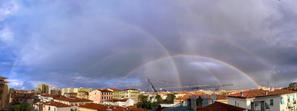Glossary term: Refraction
Description: Refraction is the way that a wave – and, specifically, light – changes direction as it passes from one medium into another. The magnitude and direction of the change depends on the "indices of refraction" of the two media, which in turn depend on the speed of light in each medium, a relation that is encoded mathematically in Snell's law of refraction. The way that light passes into a piece of glass can be used to create a lens, which bundles parallel light rays – such as the light of a distant star – falling onto the lens. This is the main effect used in constructing refracting telescopes. Refraction also depends on the wavelength of the infalling light, a fact that can be used as in a prism, to separate light by wavelength into its constituent elementary colors – which is important for documenting and examining spectra.
Related Terms:
See this term in other languages
Term and definition status: This term and its definition have been approved by a research astronomer and a teacher
The OAE Multilingual Glossary is a project of the IAU Office of Astronomy for Education (OAE) in collaboration with the IAU Office of Astronomy Outreach (OAO). The terms and definitions were chosen, written and reviewed by a collective effort from the OAE, the OAE Centers and Nodes, the OAE National Astronomy Education Coordinators (NAECs) and other volunteers. You can find a full list of credits here. All glossary terms and their definitions are released under a Creative Commons CC BY-4.0 license and should be credited to "IAU OAE".
Related Media
24 Hours of Rainbow
Credit: Fabrizio Guasconi/IAU OAE (CC BY 4.0)
License: CC-BY-4.0 Creative Commons Attribution 4.0 International (CC BY 4.0) icons









